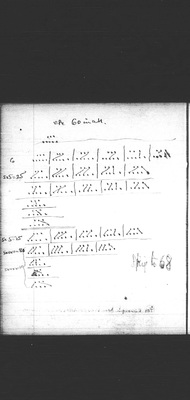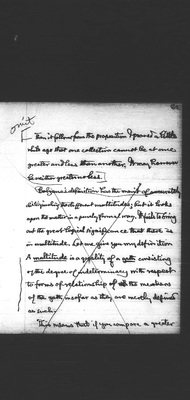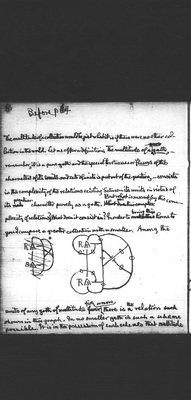Pages
57
60 Begin
On Balzano's definition of greater and less can be based a definition of Multitude. That is the multitude of a collection will be defined as consisting in its being greater than those collections that is greater than and being less than those it is less than. This definition is at least a practicable one. It can be put to use in demonstrations. In that respect it is infinitely better than what Cantor puts forth as a definition in the style of Kant, who was a superb logical genius but who never studied logic and therefore sometimes commits grievous faults of logic. Namely Cantor tells us that if we think of a collection & then put out of view this and that element of our idea, what remains is multitude. But that is no definition at all. It is an experiment telling us granting for the sake of argument that it attains its aim how to find and identify multitude. A definition ought to be an analysis of a conception useful in demonstration. The purely relative definition based on Balzano's definition of greater and less does that. But it takes too narrow and formal a view of the matter. It fails to show the immense logical significance of multitude. It also makes it to be a purely relative between one collection & others. That is not true.
59
Before p 64{?}
The multitude of a collection would be just what it is if there were no other collection in the world. Let me offer a definition. The multitude of a gath,— remember, it is a pure gath and the special firstnesses or flavors of the characters of its units and sets of units is put out of the question,— consists in the complexity of the relations existing between its units in virtue of its peculiar character purely as a gath. But what is meant by the complexity of relations? What does it consist in? In order to bring this home to you I compare a greater collection with a smaller. Among the
[diagram]
units of any gath of multitude five or more there is the relation shown in this graph. In no smaller gath is such a scheme possible. It is in the possession of such schemes that multitude
60
64 After p 63[?]
consists. But every such scheme holds for every gath, except for the cuts that ligatures traverse. That is to say every form of relationship exists between the members of all gaths alike, except in respect to the identity and diversity of the correlates. We may go further. Every scheme holds for every gath if there are no cuts. Therefore multitude consists in the complexity of indefinite relationships between the units of a gath as such. But this complexity consists solely in the diversity of correlates. Hence the multitude of a gath consists in the othernesses among its units that the multitude permits. This is so obvious that it is truly wonderful that nobody has ever said it before this minute, when I say it to you. On the other hand, the smallness of a collection expressed by enclosing such a scheme in a cut, consists in the necessitation of identities.
Now some logicians look upon every proposition as expressing a description of identity. That may be a contorted conception of a proposition, but it is not




